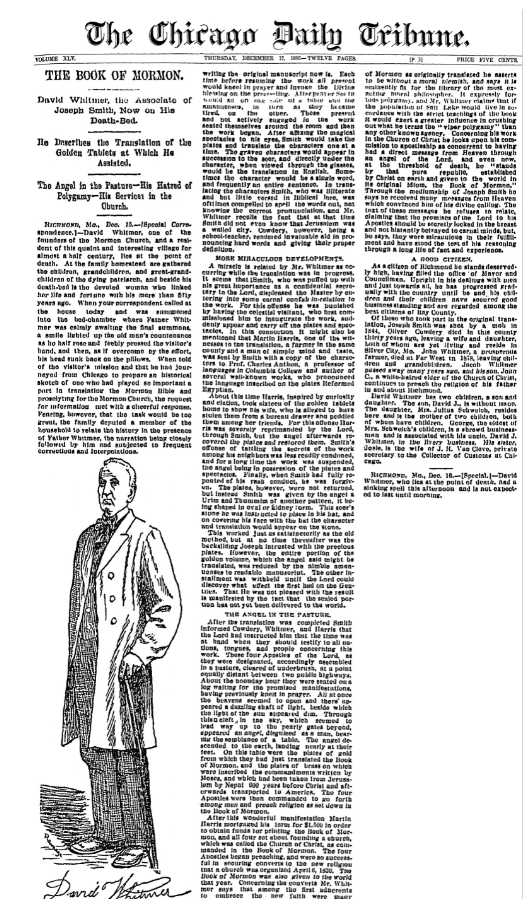David Whitmer recounts Joseph using Urim and Thummim to translate the Book of Mormon.
- Type
- News (traditional)
- Hearsay
- Scribed SummaryLateJournalism
- Reference
"The Book of Mormon,' Chicago Tribune, December 17, 1885: 3
- Scribe/Publisher
- Chicago Tribune
- People
- Martin Harris, Emma Hale Smith, Chicago Tribune, Christian Whitmer, David Whitmer, Joseph Smith, Jr., Oliver Cowdery
- Audience
- General Public
- Transcription
In order to give privacy to the proceeding a blanket, which served as a portière, was stretched across the family living room to shelter the translators and the plates from the eyes of any who might call at the house while the work was in progress. This, Mr. Whitmer says, was the only use made of the blanket, and it was not for the purpose of concealing the plates or the translator from the eyes of the amanuensis. In fact, Smith was at no time hidden from his collaborators, and the translation was performed in the presence of not only the persons mentioned, but of the entire Whitmer household and several of Smith’s relatives besides. The work of translating the tablets consumed about eight months, Smith acting as the seer and Oliver Cowdery, Smith’s wife, and Christian Whitmer, brother of David, performing the duties of amanuenses, in whose handwriting the original manuscript now is. Each time before resuming the work all present would kneel in prayer and invoke the Divine blessing on the proceeding. After prayer Smith would sit on one side of a table and the amanuenses, in turn as they became tired, on the other. Those present and not actively engaged in the work seated themselves around the room and then the work began. After affixing the magical spectacles to his eyes, Smith would take the plates and translate the characters one at a time. The graven characters would appear in succession to the seer, and directly under the character, when viewed through the glasses, would be the translation in English. Sometimes the character would be a single word, and frequently an entire sentence. In translating the characters Smith, who was illiterate and but little versed in Biblical lore, was ofttimes compelled to spell the words out, not knowing the correct pronunciation, and Mr. Whitmer recalls the fact that at that time Smith did not even know that Jerusalem was a walled city. Cowdery, however, being a school-teacher, rendered invaluable aid in pronouncing hard words and giving their proper definition. . . . It seems that Smith, who was puffed up with his great importance as a confidential secretary to the Lord, displeased the Master by entering into some carnal confab in relation to the work. For this offense he was punished by having the celestial visitant, who first commissioned him to inaugurate the work, suddenly appear and carry off the plates and spectacles. . . . . . . Smith’s offense of tattling the secrets of the work among his neighbors was less readily condoned [than Harris losing the 116 pages], and for a long time the work was suspended, the angel being in possession of the plates and spectacles. Finally, when Smith had fully repented of his rash conduct, he was forgiven. The plates, however, were not returned, but instead Smith was given by the angel a Urim and Thummim of another pattern, it being shaped in oval or kidney form. This seer’s stone he was instructed to place in his hat, and on covering his face with the hat the character and translation would appear on the stone. This worked just as satisfactorily as the old method, but at no time thereafter was the backsliding Joseph intrusted with the precious plates. However, the entire portion of the golden volume, which the angel said might be translated, was reduced by the nimble amanuenses to readable manuscript.
- Citations in Mormonr Qnas
The B. H. Roberts Foundation is not owned by, operated by, or affiliated with the Church of Jesus Christ of Latter-day Saints.

